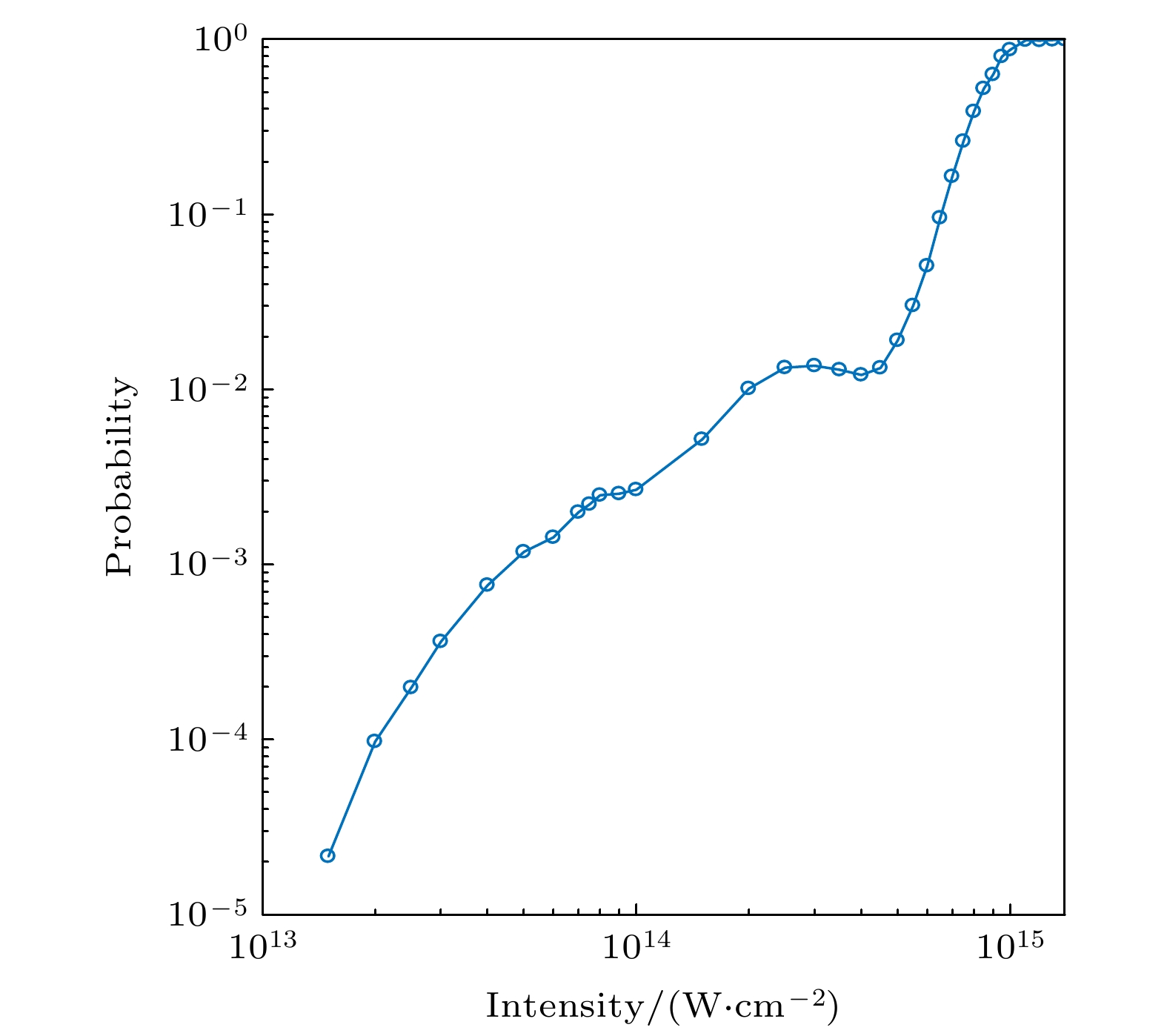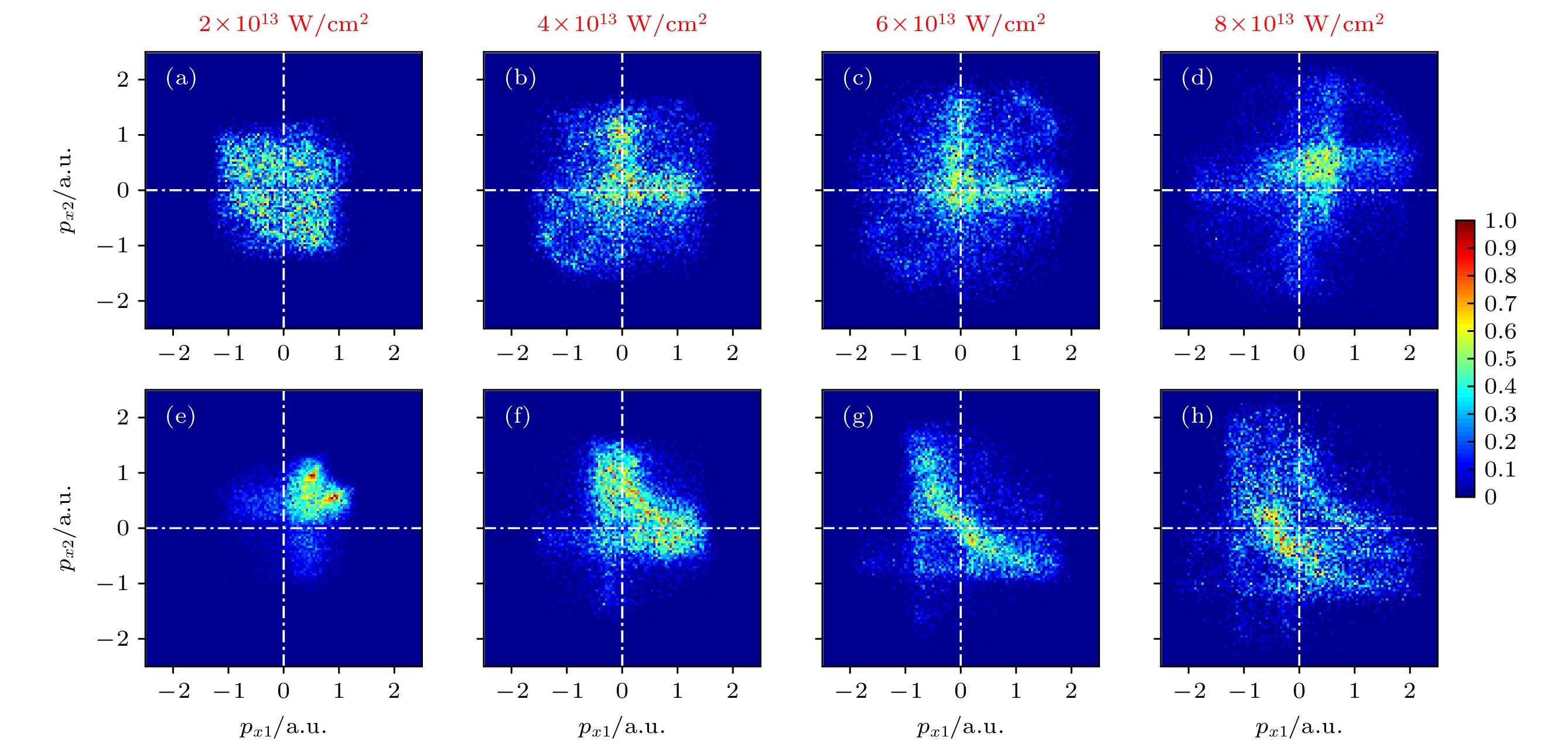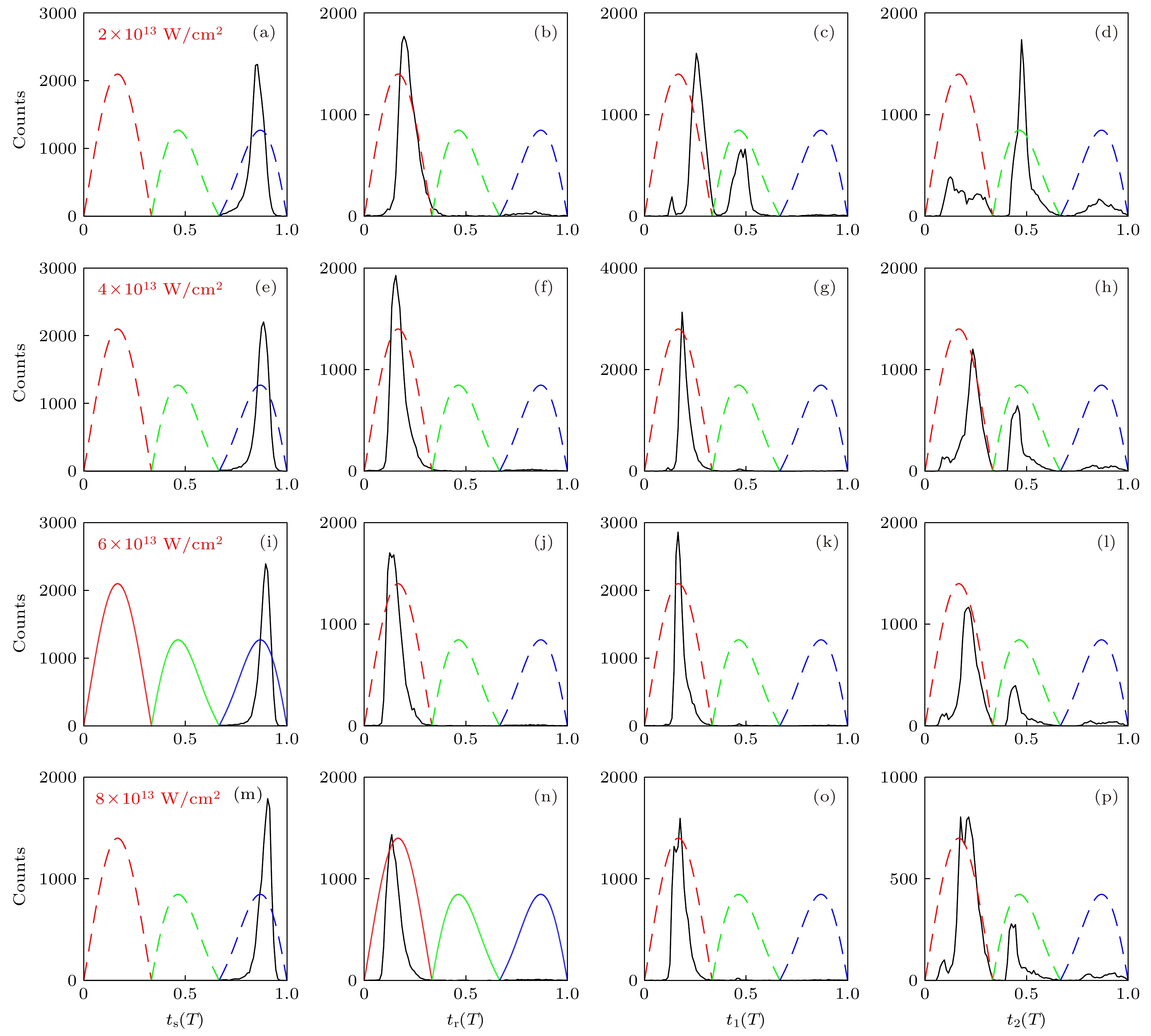-
本文利用三维经典系综模型研究了反向旋转双色椭偏(two-color elliptically polarized, TCEP)场中Ar原子非次序双电离(nonsequential double ionization, NSDI)的电子关联特性和再碰撞动力学. 数值结果显示随激光强度的增大, 电子对在x方向的关联动量分布从位于第一象限的V形结构逐渐演变成主要分布于二、四象限的弧形结构, 最后过渡到主要位于第一象限的近原点分布. 其主要的关联行为从正相关演变成反相关再到正相关. 两脉冲组成的复合电场波形呈现出三叶草的形状, 即1个周期的电场由3个不同方向的“叶片”组成, 每个“叶片”称为一个波瓣, 根据时间演化的顺序分别将其称为波瓣1、波瓣2和波瓣3. 轨道分析发现, NSDI事件中单电离主要发生在波瓣1和波瓣3, 且随强度的增大波瓣1的贡献越来越大, 波瓣3的贡献越来越小. 相应地电子主要从20°和175°两个方向返回母离子, 且随强度的增大, 20°附近返回的电子逐渐增多, 175°附近返回的电子逐渐减少.Electron correlation behaviors and recollision dynamics in nonsequential double ionization (NSDI) of Ar atoms in a counter-rotating two-color elliptically polarized (TCEP) field are investigated by using a three-dimensional classical ensemble model. The numerical results show that the correlated momentum distribution of electron pairs in the x-axis direction evolves from a V-shaped structure in the first quadrant at the low intensity, to an arc-shaped structure mainly located in the second and fourth quadrants at moderate intensity, finally to a distribution near the origin located in the first quadrant in the high intensity. With the laser intensity increasing, the dominant correlation behavior evolves from correlation to anti-correlation and finally reverts back to correlation. The combined electric field traces out a trefoil pattern, i.e. the waveform in a period shows three leaves in different directions. Each leaf is called a lobe. The electric field recursively evolves from lobe 1 to lobe 2 and to lobe 3. Unlike the counter-rotating two-color circularly polarized fields, the combined fields from two elliptical fields do not have the spatial symmetry. Amplitudes of the three field lobes and the angles between them are different. Furthermore, the back analysis of NSDI trajectories shows that the single ionization in NSDI events mainly occurs in lobe 1 and lobe 3, and the contribution from lobe 1 increases and that from lobe 3 decreases with the increase of the intensity. Correspondingly, the free electrons mainly return to the parent ion from 20° and 175°. With the laser intensity increasing, the electrons returning from 20° gradually increase and those returning from 175° gradually decrease. In order to further understand the correlation behaviors of electron pairs in the x-axis direction, the NSDI events triggered off by single ionization from different lobes are separately discussed. With the increase of laser intensity the correlation behavior of NSDI events triggered off by single ionization from field lobe 1 evolves from anti-correlation behavior to correlation behavior, but the correlation behavior of NSDI events induced by single ionization from field lobe 3 evolves from correlation behavior to anti-correlation behavior. With the laser intensity increasing, the NSDI events induced by single ionization from field lobe 1 increase gradually, but those from field lobe 3 decrease. This results in that the total dominant correlation behavior evolves from correlation to anti-correlation and finally reverts back to correlation as the laser intensity increases.
-
Keywords:
- two-color elliptically polarized fields /
- nonsequential double ionization /
- electron correlation /
- recollision
[1] Fittinghoff D N, Bolton P R, Chang B, Kulander K C 1992 Phys. Rev. Lett 69 2642
 Google Scholar
Google Scholar
[2] Corkum P B 1993 Phys. Rev. Lett 71 1994
 Google Scholar
Google Scholar
[3] Feuerstein B, Moshammer R, Fischer D, Dorn A, Schröter C D, Deipenwisch J, Crespo Lopez-Urrutia J R, Höhr C, Neumayer P, Ullrich J, Rottke H, Trump C, Wittmann M, Korn G, Sandner W 2001 Phys. Rev. Lett 87 043003
 Google Scholar
Google Scholar
[4] Chen Y B, Zhou Y M, Li Y, Li M, Lan P F, Lu P X 2018 Phys. Rev. A 97 013428
 Google Scholar
Google Scholar
[5] Liu Y Q, Fu L B, Ye D F, Liu J, Li M, Wu C Y, Gong Q H, Moshammer R, Ullrich J 2014 Phys. Rev. Lett 112 013003
 Google Scholar
Google Scholar
[6] Huang C, Guo W L, Zhou Y M, Wu Z M 2016 Phys. Rev. A 93 013416
 Google Scholar
Google Scholar
[7] Liao Q, Winney A H, Lee S K, Lin Y F, Adhikari P, Li W 2017 Phys. Rev. A 96 023401
 Google Scholar
Google Scholar
[8] Ye D F, Li M, Fu L, Liu J, Gong Q H, Liu Y Q, Ullrich J 2015 Phys. Rev. Lett 115 123001
 Google Scholar
Google Scholar
[9] Weber Th, Giessen H, Weckenbrock M, Urbasch G, Staudte A, Spielberger L, Jagutzki O, Mergel V, Vollmer M, Dörner R 2000 Nature 405 658
 Google Scholar
Google Scholar
[10] Wang Y L, Xu S P, Quan W, Gong C, Lai X Y, Hu S L, Liu M Q, Chen J, Liu X J 2016 Phys. Rev. A 94 053412
 Google Scholar
Google Scholar
[11] Figueira de Morisson Faria C, Liu X 2011 J. Mod. Opt 58 1076
 Google Scholar
Google Scholar
[12] Becker W, Liu X, Jo Ho P, Eberly J H 2012 Rev. Mod. Phys 84 1011
 Google Scholar
Google Scholar
[13] Li H, Chen J, Jiang H, Liu J, Fu P, Gong Q, Yan Z, Wang B 2009 J. Phys. B 42 125601
 Google Scholar
Google Scholar
[14] Zhou Y M, Liao Q, Lu P X 2009 Phys. Rev. A 80 023412
 Google Scholar
Google Scholar
[15] Wang X, Eberly J H 2010 Phys. Rev. Lett 105 083001
 Google Scholar
Google Scholar
[16] Hao X L, Chen J, Li W D, Wang B B, Wang X D, Becker W 2014 Phys. Rev. Lett 112 073002
 Google Scholar
Google Scholar
[17] Chen Z J, Liang Y Q, Lin C D 2010 Phys. Rev. Lett 104 253201
 Google Scholar
Google Scholar
[18] Huang C, Zhong M, Wu Z 2019 Opt. Express 27 7616
 Google Scholar
Google Scholar
[19] Li Y, Yu B H, Tang Q, Wang X, Hua D, Tong A, Jiang C, Ge G, Li Y, Wan J 2016 Opt. Express 24 6469
 Google Scholar
Google Scholar
[20] Zhou Y M, Huang C, Tong A, Liao Q, Lu P X 2011 Opt. Express 19 2301
 Google Scholar
Google Scholar
[21] Li M, Jiang W C, Xie H, Luo S Q, Zhou Y M, Lu P X 2018 Phys. Rev. A 97 023415
 Google Scholar
Google Scholar
[22] Chaloupka J L, Hickstein D D 2016 Phys. Rev. Lett 116 143005
 Google Scholar
Google Scholar
[23] Mancuso C A, Dorney K M, Hickstein D D, Chaloupka J L, Ellis J L, Dollar F J, Knut R, Grychtol P, Zusin D, Gentry C, Gopalakrishnan M, Kapteyn H C, Murnane M M 2016 Phys. Rev. Lett 117 133201
 Google Scholar
Google Scholar
[24] Eckart S, Richter M, Kunitski M, Hartung A, Rist J, Henrichs K, Schlott N, Kang H, Bauer T, Sann H, Schmidt L P H, Schoffler M, Jahnke T, Dorner R 2016 Phys. Rev. Lett 117 133202
 Google Scholar
Google Scholar
[25] Lin K, Jia X, Yu Z, He F, Ma J, Li H, Gong X, Song Q, Ji Q, Zhang W, Li H, Lu P X, Zeng H, Chen J, Wu J 2017 Phys. Rev. Lett 119 203202
 Google Scholar
Google Scholar
[26] Li B, Yang X, Ren X, Zhang J 2019 Opt. Express 27 32700
 Google Scholar
Google Scholar
[27] Huang C, Zhong M, Wu Z 2018 Opt. Express 26 26045
 Google Scholar
Google Scholar
[28] Xu T, Zhu Q, Chen J, Ben S, Zhang J, Liu X 2018 Opt. Express 26 1645
 Google Scholar
Google Scholar
[29] Huang C, Pang H L, Huang X F, Zhong M, Wu Z 2020 Opt. Express 28 10505
 Google Scholar
Google Scholar
[30] Peng M, Bai L, Guo Z 2021 Commun. Theor. Phys 73 075501
 Google Scholar
Google Scholar
[31] Ma X, Zhou Y M, Chen Y, Li M, Li Y, Zhang Q, Lu P X 2019 Opt. Express 27 1825
 Google Scholar
Google Scholar
[32] Chen Z, Su J, Zeng X, Huang X F, Li Y B, Huang C 2021 Opt. Express 29 29576
 Google Scholar
Google Scholar
[33] Peng M, Bai L H 2020 Chin. Opt. Lett 18 110201
 Google Scholar
Google Scholar
[34] Busuladžić M, Čerkić A, Gazibegović-Busuladžić A, Hasović E, Milošević D B 2018 Phys. Rev. A 98 013413
 Google Scholar
Google Scholar
[35] 黄雪飞, 苏杰, 廖健颖, 李盈傧, 黄诚 2022 71 093202
 Google Scholar
Google Scholar
Huang X F, Su J, Liao J Y, Li Y B, Huang C 2022 Acta Phys. Sin. 71 093202
 Google Scholar
Google Scholar
[36] Xu T T, Chen J H, Pan X, Zhang H, Ben S, Liu X 2018 Chin. Phys. B 27 093201
 Google Scholar
Google Scholar
[37] Chen J H, Xu T T, Han T, Sun Y, Xu Q, Liu X 2020 Chin. Phys. B 29 013203
 Google Scholar
Google Scholar
[38] Chen J, Nam C H 2002 Phys. Rev. A 66 053415
 Google Scholar
Google Scholar
[39] Panli R, Eberly J H, Haan S L 2001 Opt. Express 8 431
 Google Scholar
Google Scholar
[40] Pang H, Huang X, Huang C 2020 Int. J. Mod. Phys. B 34 2050304
 Google Scholar
Google Scholar
[41] Su J, Liu Z, Liao J, Huang X, Li Y, Huang C 2022 Opt. Express 30 24898
 Google Scholar
Google Scholar
[42] Li Y, Wang X, Yu B, Tang B, Wang G, Wan J 2016 Sci. Rep 6 37413
 Google Scholar
Google Scholar
[43] Li Y, Xu J, Chen H, Li Y, He J, Qin L, Shi L, Zhao Y, Tang Q, Zhai C, Yu B 2021 Opt. Commun 493 127019
 Google Scholar
Google Scholar
[44] 曾雪, 苏杰, 黄雪飞, 庞惠玲, 黄诚 2021 70 243201
 Google Scholar
Google Scholar
Zeng X, Su J, Huang X, Pang H L, Huang C 2021 Acta Phys. Sin. 70 243201
 Google Scholar
Google Scholar
-
图 4 单电离时间(第1列) 、碰撞时间(第2列) 、碰撞后第1个(第3列)和第2个电子(第4列)的最终电离时间的统计分布. 为了更清楚显示碰撞和电离时刻的激光相位, 将碰撞时间和电离时间转换到一个激光周期, 其中彩色虚线给出了复合电场幅值的时间演化. 激光强度分别 2 × 1013 W/cm2 (第1行)、4 × 1013 W/cm2 (第2行) 、 6 × 1013 W/cm2 (第3行) 和8 × 1013 W/cm2 (第4行)
Fig. 4. Distributions of single ionization time (the first column), recollision time (the second column) and final ionization times of the first (the third column) and second electron (the fourth column) after recollision for the intenstiies of 2 × 1013 W/cm2 (the first row), 4 × 1013 W/cm2 (the second row), 6 × 1013 W/cm2 (the third row) and 8 × 1013 W/cm2 (the fourth row). To more clearly show the laser phases of the recollision and ionization instants, the recollision and ionization times are transfered to one laser cycle. The dashed curve shows the combined electric field.
图 6 波瓣1处单电离诱导的NSDI事件的单电离时间(第1列) 、碰撞时间(第2列) 、碰撞后第1个(第3列)和第2个电子(第4列)的最终电离时间的统计分布, 其他参数与图4相同
Fig. 6. Distributions of single ionization time (the first column), recollision time (the second column) and final ionization times of the first (the third column) and second electron (the fourth column) after recollision for those NSDI events induced by single ionization at field lobe 1. Other parameters are the same as Fig. 4.
图 7 波瓣3处单电离诱导的NSDI事件的单电离时间(第1列) 、碰撞时间(第2列) 、碰撞后第1个(第3列)和第2个电子(第4列)的最终电离时间的统计分布, 其他参数与图4相同
Fig. 7. Distributions of single ionization time (the first column), recollision time (the second column) and final ionization times of the first (the third column) and second electron (the fourth column) after recollision for those NSDI events induced by single ionization at field lobe 3, other parameters are the same as Fig. 4.
-
[1] Fittinghoff D N, Bolton P R, Chang B, Kulander K C 1992 Phys. Rev. Lett 69 2642
 Google Scholar
Google Scholar
[2] Corkum P B 1993 Phys. Rev. Lett 71 1994
 Google Scholar
Google Scholar
[3] Feuerstein B, Moshammer R, Fischer D, Dorn A, Schröter C D, Deipenwisch J, Crespo Lopez-Urrutia J R, Höhr C, Neumayer P, Ullrich J, Rottke H, Trump C, Wittmann M, Korn G, Sandner W 2001 Phys. Rev. Lett 87 043003
 Google Scholar
Google Scholar
[4] Chen Y B, Zhou Y M, Li Y, Li M, Lan P F, Lu P X 2018 Phys. Rev. A 97 013428
 Google Scholar
Google Scholar
[5] Liu Y Q, Fu L B, Ye D F, Liu J, Li M, Wu C Y, Gong Q H, Moshammer R, Ullrich J 2014 Phys. Rev. Lett 112 013003
 Google Scholar
Google Scholar
[6] Huang C, Guo W L, Zhou Y M, Wu Z M 2016 Phys. Rev. A 93 013416
 Google Scholar
Google Scholar
[7] Liao Q, Winney A H, Lee S K, Lin Y F, Adhikari P, Li W 2017 Phys. Rev. A 96 023401
 Google Scholar
Google Scholar
[8] Ye D F, Li M, Fu L, Liu J, Gong Q H, Liu Y Q, Ullrich J 2015 Phys. Rev. Lett 115 123001
 Google Scholar
Google Scholar
[9] Weber Th, Giessen H, Weckenbrock M, Urbasch G, Staudte A, Spielberger L, Jagutzki O, Mergel V, Vollmer M, Dörner R 2000 Nature 405 658
 Google Scholar
Google Scholar
[10] Wang Y L, Xu S P, Quan W, Gong C, Lai X Y, Hu S L, Liu M Q, Chen J, Liu X J 2016 Phys. Rev. A 94 053412
 Google Scholar
Google Scholar
[11] Figueira de Morisson Faria C, Liu X 2011 J. Mod. Opt 58 1076
 Google Scholar
Google Scholar
[12] Becker W, Liu X, Jo Ho P, Eberly J H 2012 Rev. Mod. Phys 84 1011
 Google Scholar
Google Scholar
[13] Li H, Chen J, Jiang H, Liu J, Fu P, Gong Q, Yan Z, Wang B 2009 J. Phys. B 42 125601
 Google Scholar
Google Scholar
[14] Zhou Y M, Liao Q, Lu P X 2009 Phys. Rev. A 80 023412
 Google Scholar
Google Scholar
[15] Wang X, Eberly J H 2010 Phys. Rev. Lett 105 083001
 Google Scholar
Google Scholar
[16] Hao X L, Chen J, Li W D, Wang B B, Wang X D, Becker W 2014 Phys. Rev. Lett 112 073002
 Google Scholar
Google Scholar
[17] Chen Z J, Liang Y Q, Lin C D 2010 Phys. Rev. Lett 104 253201
 Google Scholar
Google Scholar
[18] Huang C, Zhong M, Wu Z 2019 Opt. Express 27 7616
 Google Scholar
Google Scholar
[19] Li Y, Yu B H, Tang Q, Wang X, Hua D, Tong A, Jiang C, Ge G, Li Y, Wan J 2016 Opt. Express 24 6469
 Google Scholar
Google Scholar
[20] Zhou Y M, Huang C, Tong A, Liao Q, Lu P X 2011 Opt. Express 19 2301
 Google Scholar
Google Scholar
[21] Li M, Jiang W C, Xie H, Luo S Q, Zhou Y M, Lu P X 2018 Phys. Rev. A 97 023415
 Google Scholar
Google Scholar
[22] Chaloupka J L, Hickstein D D 2016 Phys. Rev. Lett 116 143005
 Google Scholar
Google Scholar
[23] Mancuso C A, Dorney K M, Hickstein D D, Chaloupka J L, Ellis J L, Dollar F J, Knut R, Grychtol P, Zusin D, Gentry C, Gopalakrishnan M, Kapteyn H C, Murnane M M 2016 Phys. Rev. Lett 117 133201
 Google Scholar
Google Scholar
[24] Eckart S, Richter M, Kunitski M, Hartung A, Rist J, Henrichs K, Schlott N, Kang H, Bauer T, Sann H, Schmidt L P H, Schoffler M, Jahnke T, Dorner R 2016 Phys. Rev. Lett 117 133202
 Google Scholar
Google Scholar
[25] Lin K, Jia X, Yu Z, He F, Ma J, Li H, Gong X, Song Q, Ji Q, Zhang W, Li H, Lu P X, Zeng H, Chen J, Wu J 2017 Phys. Rev. Lett 119 203202
 Google Scholar
Google Scholar
[26] Li B, Yang X, Ren X, Zhang J 2019 Opt. Express 27 32700
 Google Scholar
Google Scholar
[27] Huang C, Zhong M, Wu Z 2018 Opt. Express 26 26045
 Google Scholar
Google Scholar
[28] Xu T, Zhu Q, Chen J, Ben S, Zhang J, Liu X 2018 Opt. Express 26 1645
 Google Scholar
Google Scholar
[29] Huang C, Pang H L, Huang X F, Zhong M, Wu Z 2020 Opt. Express 28 10505
 Google Scholar
Google Scholar
[30] Peng M, Bai L, Guo Z 2021 Commun. Theor. Phys 73 075501
 Google Scholar
Google Scholar
[31] Ma X, Zhou Y M, Chen Y, Li M, Li Y, Zhang Q, Lu P X 2019 Opt. Express 27 1825
 Google Scholar
Google Scholar
[32] Chen Z, Su J, Zeng X, Huang X F, Li Y B, Huang C 2021 Opt. Express 29 29576
 Google Scholar
Google Scholar
[33] Peng M, Bai L H 2020 Chin. Opt. Lett 18 110201
 Google Scholar
Google Scholar
[34] Busuladžić M, Čerkić A, Gazibegović-Busuladžić A, Hasović E, Milošević D B 2018 Phys. Rev. A 98 013413
 Google Scholar
Google Scholar
[35] 黄雪飞, 苏杰, 廖健颖, 李盈傧, 黄诚 2022 71 093202
 Google Scholar
Google Scholar
Huang X F, Su J, Liao J Y, Li Y B, Huang C 2022 Acta Phys. Sin. 71 093202
 Google Scholar
Google Scholar
[36] Xu T T, Chen J H, Pan X, Zhang H, Ben S, Liu X 2018 Chin. Phys. B 27 093201
 Google Scholar
Google Scholar
[37] Chen J H, Xu T T, Han T, Sun Y, Xu Q, Liu X 2020 Chin. Phys. B 29 013203
 Google Scholar
Google Scholar
[38] Chen J, Nam C H 2002 Phys. Rev. A 66 053415
 Google Scholar
Google Scholar
[39] Panli R, Eberly J H, Haan S L 2001 Opt. Express 8 431
 Google Scholar
Google Scholar
[40] Pang H, Huang X, Huang C 2020 Int. J. Mod. Phys. B 34 2050304
 Google Scholar
Google Scholar
[41] Su J, Liu Z, Liao J, Huang X, Li Y, Huang C 2022 Opt. Express 30 24898
 Google Scholar
Google Scholar
[42] Li Y, Wang X, Yu B, Tang B, Wang G, Wan J 2016 Sci. Rep 6 37413
 Google Scholar
Google Scholar
[43] Li Y, Xu J, Chen H, Li Y, He J, Qin L, Shi L, Zhao Y, Tang Q, Zhai C, Yu B 2021 Opt. Commun 493 127019
 Google Scholar
Google Scholar
[44] 曾雪, 苏杰, 黄雪飞, 庞惠玲, 黄诚 2021 70 243201
 Google Scholar
Google Scholar
Zeng X, Su J, Huang X, Pang H L, Huang C 2021 Acta Phys. Sin. 70 243201
 Google Scholar
Google Scholar
计量
- 文章访问数: 6166
- PDF下载量: 92
- 被引次数: 0














 下载:
下载:







